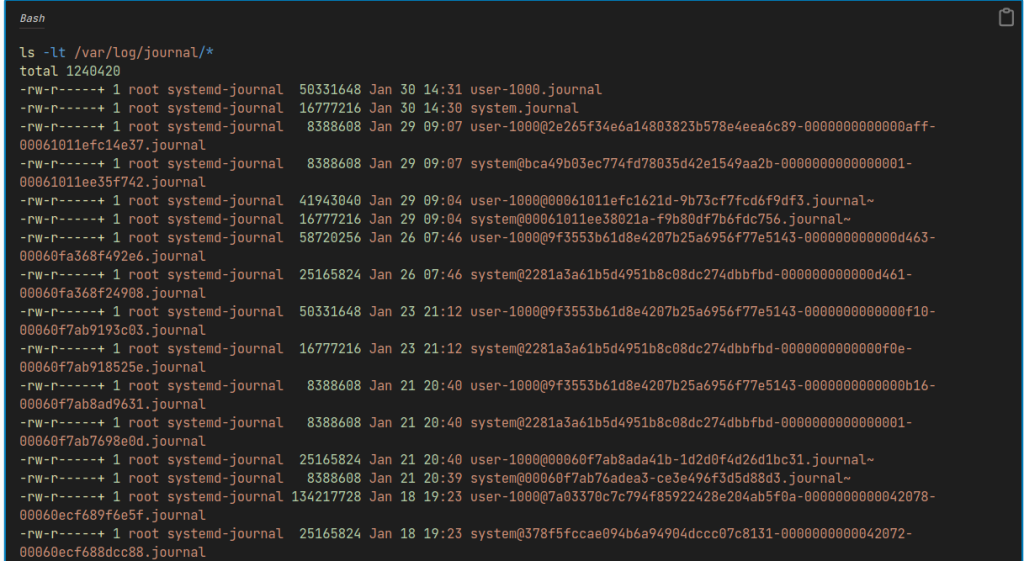[SOLVED] Free Up Disk Space on Linux Quickly
Need to Free Up Disk Space on a Linux Server or Desktop? You’ve come to the right place. Perhaps you have seen our other article about how to check disk space on Linux. If you are in a hurry. Skip to Step 1 below.
When facing low disk space issues on a Linux system, several symptoms may indicate the problem.
Here are some common signs to look out for:

Warning Messages:
Linux systems often generate warning messages when the available disk space is critically low. Look for alerts regarding low disk space in system notifications, logs, or terminal messages.
Failed Software Updates:
If you notice that software updates or installations are failing, it could be due to insufficient disk space. The package manager might require space to download and install updates.


Slow System Performance:
Low disk space can significantly impact system performance. As the available space decreases, applications and the system’s response times may slow.
Application Errors:
Some applications may start throwing errors or crash unexpectedly when they can’t write data due to a lack of disk space. Check application logs for any error messages related to disk space issues.


Unresponsive System:
In extreme cases, a lack of disk space may render the system unresponsive. The operating system may struggle to perform basic functions, leading to freezing or crashing.
Unable to Save Files:
If you can’t save new files or data, it could be a clear indication of insufficient disk space. The operating system needs space to write and store user data.


Difficulty Logging In:
Insufficient disk space can affect the ability to log in, especially if the system requires space to create temporary files during the login process.
System Warnings in GUI:
Graphical user interfaces (GUIs) in Linux environments often provide visual warnings or alerts when disk space runs low. This could include notifications on the desktop or file manager.

How to Free Up Disk Space on Linux
Step 1 – Work out What Is using the Disk Space
This is often the trickiest part of the entire process. It can be hard to know what is eating up your disk space. Is it a process that has gone rogue, or is it a log file that is spamming verbose? Who knows! But let’s find out how to Free Up Disk Space on Linux.
The easiest way to read your hard disk is to use the du command. If you just use the du command, it will list endless directories, which is not very helpful. You could narrow it down by using a specific folder to check, but that only works if you know what folder is filling up your hard drive.
For Example, let’s check my /tmp folder but only list the top 10 biggest folders.
sudo du -h --max-depth=1 /tmp | sort -rh | head -n 11Below is my output. You can see the root of /tmp is 270 MB in size, and listed are the biggest 10 folders, sorted by size, largest to smallest.
270M /tmp
269M /tmp/ollama2115724660
744K /tmp/v8-compile-cache-1000
342K /tmp/snap-private-tmp
222K /tmp/pkg-TqDcR8
30K /tmp/.com.google.Chrome.tGZUvs
18K /tmp/systemd-private-1f1b7e094b504f18891cf3247dddd4e4-upower.service-uPEGSc
18K /tmp/systemd-private-1f1b7e094b504f18891cf3247dddd4e4-systemd-timesyncd.service-s4RoAW
18K /tmp/systemd-private-1f1b7e094b504f18891cf3247dddd4e4-systemd-resolved.service-sAq0tJ
18K /tmp/systemd-private-1f1b7e094b504f18891cf3247dddd4e4-systemd-oomd.service-GYMie5
18K /tmp/systemd-private-1f1b7e094b504f18891cf3247dddd4e4-systemd-logind.service-J4DnMAYou can repeat this against the entire filesystem if you want.
du -h --max-depth=1 / 2>/dev/null | sort -rh | awk '{if ($1 != "0") printf "%-40s%-10s\n", $2, $1}' | head -n 11This is my output
/ 79G
/home 38G
/snap 17G
/usr 13G
/var 8.7G
/installables 2.6G
/boot 353M
/opt 321M
/etc 16M
/run 3.1M
/tmp 1.4M You can immediately see that my home folder is the biggest folder on my system, a perfect start to Freeing up Disk Space on Linux.
Here are some of my favorite disk space commands:
#List Top Disk-consuming Files:
find / -type f -exec du -h {} + | sort -rh | head -n 10
#List Top Disk-consuming Directories:
du -h --max-depth=1 /path/to/directory | sort -rh | head -n 11
#Find Large Files in Home Directory:
find ~/ -type f -exec du -h {} + | sort -rh | head -n 10
#Identify Large Files Older Than X Days:
find / -type f -mtime +X -exec du -h {} + | sort -rh | head -n 10
#Find Large Log Files:
find /var/log -type f -size +100M -exec ls -lh {} + | awk '{print $9, $5}'
Want to delete the files too?

find /var/log -type f -size +100M -exec rm {} +Step 2 – Clean Package Cache (Debian / Ubuntu)
If you install packages frequently, or if you have just upgraded/updated your systems. There is a good chance your apt-cache can be cleared down to Free Up Disk Space on Linux.
Want to see how much of your cache is being used? You can run this command:
du -sh /var/cache/aptYou will see output similar to this:
530M /var/cache/aptTo clear the cache just type:
sudo apt-get cleanStep 3 – Clear down old Linux Kernel to Free Up Disk Space on Linux
When you update your Operating System, the Kernel is not always cleaned by default. This is because in the event of a system crash, you can always change the kernel used at System Boot. However, over time the number of Kernels will grow, and clearing them down is a great way to Free Up Disk Space on Linux.
Keep in mind that the actual packages might include architecture-specific information (e.g., “linux-image-5.4.0-72-generic” for a specific version). If you want to see only the version numbers, you may need to parse the output further.
dpkg-query -W -f='${binary:Package}\t${Version}\t${Installed-Size}\n' | grep linux-image | awk '{printf "%s\t%s\t%.2f MB\n", $1, $2, $3/1024}'This command retrieves information about installed Debian packages, filters for those related to Linux kernel images, and then prints a formatted list containing the package name, version, and installed size in megabytes.
You will see output similar to this:
dpkg-query -W -f='${binary:Package}\t${Version}\t${Installed-Size}\n' | grep linux-image | awk '{printf "%s\t%s\t%.2f MB\n", $1, $2, $3/1024}'
linux-image-5.19.0-32-generic 5.19.0-32.33~22.04.1 11.65 MB
linux-image-5.19.0-46-generic 5.19.0-46.47~22.04.1 11.69 MB
linux-image-6.2.0-26-generic 6.2.0-26.26~22.04.1 13.17 MB
linux-image-6.2.0-31-generic 6.2.0-31.31~22.04.1 13.19 MB
linux-image-6.2.0-32-generic 6.2.0-32.32~22.04.1 13.19 MB
linux-image-6.2.0-33-generic 6.2.0-33.33~22.04.1 13.18 MB
linux-image-6.2.0-34-generic 6.2.0-34.34~22.04.1 13.19 MB
linux-image-6.2.0-35-generic 6.2.0-35.35~22.04.1 13.19 MB
linux-image-6.2.0-36-generic 6.2.0-36.37~22.04.1 13.19 MB
linux-image-6.2.0-37-generic 6.2.0-37.38~22.04.1 13.19 MB
linux-image-6.2.0-39-generic 6.2.0-39.40~22.04.1 13.19 MB
linux-image-6.5.0-14-generic 6.5.0-14.14~22.04.1 13.60 MB
linux-image-6.5.0-15-generic 6.5.0-15.15~22.04.1 13.61 MB
linux-image-generic-hwe-22.04 6.5.0.15.15~22.04.8 0.02 MB
If you are happy to remove the Kernel, you can do so by using this command. You may want to keep at least one or two older kernels as a backup in case there are issues with the latest one. Always check that your system is stable after removing old kernels before proceeding further.

sudo apt-get remove <kernel-package-name>Step 4 – Truncate Log Files to Free Up Disk Space on Linux
The /var/log directory on a Linux system is where various log files are stored. These log files contain information about system events, processes, and applications.
Examples of common log files within /var/log:
syslog: General system log file capturing a variety of events.auth.logorsecure: Logs related to authentication and security.messages: General system messages.kern.log: Kernel-related messages.apache2/access.logandapache2/error.log: Apache web server access and error logs.mysql/error.log: MySQL database server error log.- Access Permissions: Usually, access to the
/var/logdirectory and its log files is restricted to system administrators (rootor users with elevated privileges) to maintain the integrity and security of the logs.
Step 4.1 – Find the Biggest Five Files
Let’s take a look at the five biggest files in my /var/log folder. Run this command:
du -h --max-depth=1 /var/log 2>/dev/null | sort -rh | awk '{if ($1 != "0") printf "%-40s%-10s\n", $2, $1}' | head -n 5This is the output I get:
/var/log/journal 1.2G
/var/log/aws-vpn-client 885K
/var/log/installer 610K
/var/log/apt 262K
/var/log/cups 89K Step 4.2 – Truncate Journal – Important Information
Stop! Before you go truncating files, make sure you understand the risk, and only do the truncate if you are certain.
/var/log/journal(1.2G):- Purpose: This directory contains logs managed by
systemd-journald. It stores system logs in a binary format. - Usage: Used for centralized and structured logging, allowing easy retrieval and analysis of system events.
- Purpose: This directory contains logs managed by
/var/log/aws-vpn-client(885K):- Purpose: Logs related to the AWS VPN client, which is a tool for connecting to AWS Virtual Private Clouds (VPCs).
- Usage: Records events and activities related to VPN connections.
/var/log/installer(610K):- Purpose: Logs related to the system installation process.
- Usage: Helpful for diagnosing issues during the installation of the operating system.
/var/log/apt(262K):- Purpose: Logs related to package management using APT (Advanced Package Tool).
- Usage: Captures information about package installations, upgrades, and removals.
/var/log/cups(89K):- Purpose: Logs for the Common Unix Printing System (CUPS), which manages printing services.
- Usage: Contains information about print jobs, errors, and printer status.
Ok. I am going to truncate my journal. I don’t need the system information saved within it and clearing 1.2gb of space is a great way to Free Up Disk Space on Linux. First, see what the content of the journal folder is:
ls -ltr /var/log/journal/*The output will look something like this:

Step 4.3 – Truncate Journal
I will now Truncate all the journals.
sudo truncate -s 0 /var/log/journal/1301d4d0705a4efca0baa670e1d1df94/*Now, when I list my folder, it truncates the logs and saves me nearly 1GB of data! What a great way to Free Up Disk Space on Linux
ls -lht /var/log/journal/*
total 10K
-rw-r-----+ 1 root systemd-journal 8.0M Jan 30 14:33 user-1000.journal
-rw-r-----+ 1 root systemd-journal 8.0M Jan 30 14:33 system.journalThat’s all for now. These are 4 of the best ways to Free Up Disk Space on Linux; just be careful.
Thanks for reading this article. If you have any questions or feedback, please write in the comment section below.




I am unable to free up any space or login to my graphical interface. Every command is met with “write error:not enough space.” Help
You will need to connect via SSH and clear space using the commands above. the GUI wont work if the server has run out of resources. You could reboot, but that carries some risk.
First thing I would check is /var/log and clear any logs that have spiraled out of control
WOW, awesomeness! Thanks a million – you have no idea what a lifesaver you’ve been!!! Seriously, I’ve been receiving msgs “low on disk space’, would eventually get around to it. Which I did when it was 100% full lol … and ofc I was frantically purging apps I installed but never used!. Deleted all my videos etc etc, terrific I’ve retrieved 40GB. But an hour later “low on disk space’ msg again. I was googling, deleting & purging all night (no jokes I had over 3680 packages – I think its alot) and I was still getting no where!. Until I stumbled on your article!!!
What a blessing! I didn’t have to do anything in step 1 (I’d cover all of those & more & still ‘nada’).
“sudo apt-get clean” and I saw the light hahaha (I was surfing the web on a mission of note & only ONE guy mentioned the cache issue; AND that’s how I got on to your article! YOU’re A GENIUS!!!
Oh did I mention that in a space of less than 15 minutes I had a 140 GB Free Disk Space!
This is why I write this blog, to help people in need.
It makes me very happy that its helped you out!